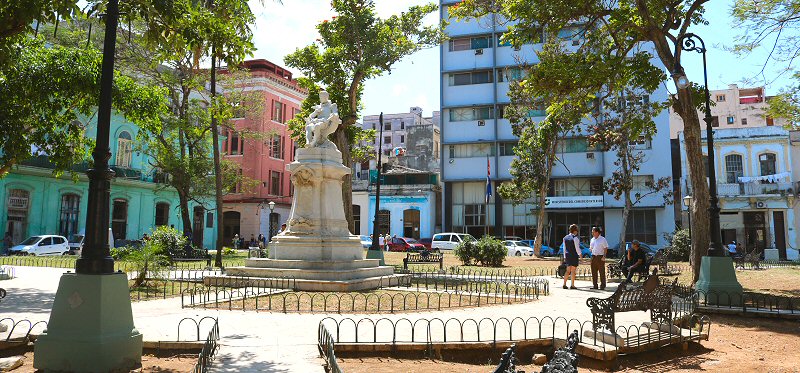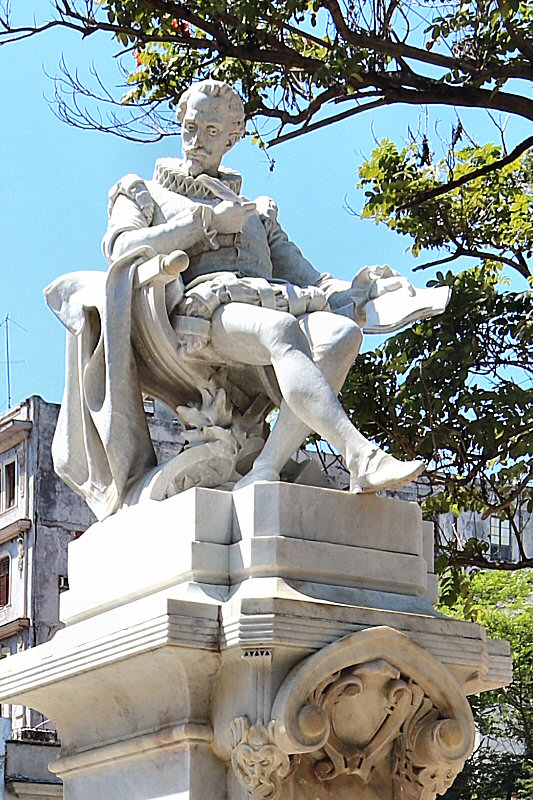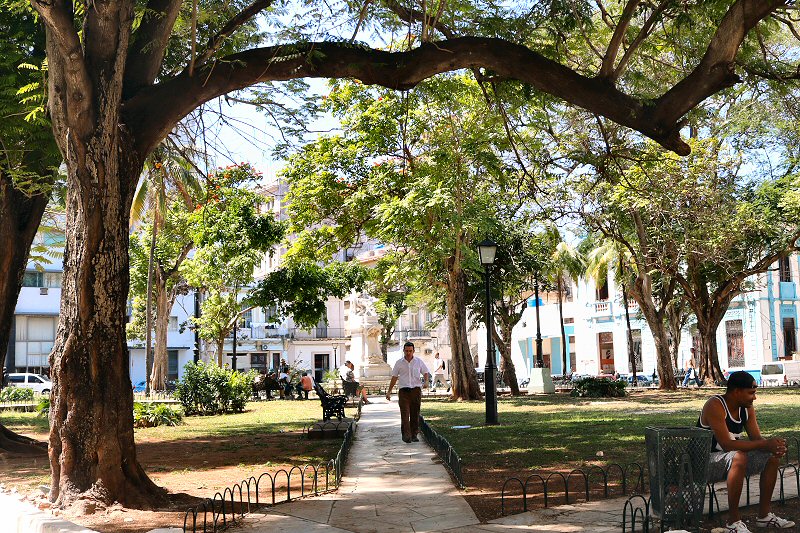
The Parque Cervantes is
located two blocks west of the Plaza de la Catedral, bordered by
the Habana, the Aguilar, the Empedrado and the San Juan de Dios
streets.
The Parque Cervantes was
inaugurated to pay tribute to the Spanish
novelist, poet and dramatist Miguel
de Cervantes y Saavedra (1547-1616),
author of the worldwide known novel El Ingenioso Hidalgo Don
Quijote de la Mancha (The Ingenious Gentleman Don
Quijote of Mancha). The official name of the park is Parque
Cervantes, but it has been known for more than a century
under the name of Plaza (Parque) San Juan de Dios.
HISTORY
In 16th century, the place
was a swampy area. When the first hospital of Villa de San
Cristobal de la Habana that had been built in 1545 close to
the plot that the Palacio de los Capitanes
Generales occupies today, was set on fire by the French
corsair Jacques de Sores in 1555, as it was a wooden
construction, covered with guano, the Governor Juan Maldonado Barnuevo ordered to rebuild the hospital in the land
adjacent to the school of San Felipe y Santiago.
The construction began in 1596 and
it was completed in 1599. It received the name of the
adjacent Colegio de San Felipe y Santiago. In 1602, by the
Royal Decree this municipal hospital that was the first
general hospital in Havana and the second in Cuba, was
turned over to the friars of the religious order San Juan de
Dios. Thus, the name of the hospital, Hopital de San Felipe
y Santiago, was changed to Hopital de San Juan de Dios and
the street in front of it was called Calle San Juan de Dios.
The first doctor of the town (Julio César) began to practice
at that time. In 1769 the hospital was handed over to a
civil administration, to Toms Mateo Cervales that changed
its name to its original name, Hopital de San Felipe y
Santiago.
The hospital was insufficient to meet the
population’s need due to limited number of beds and the
disastrous hygienic conditions. The people were changing
their route because of the bad smell that came from inside.
Cirilo Villaverde, the author of the novel Cecilia Valdés
that considered a true reflection of the reality about the
Cuban society in the 19th century, made a reference to this
situation by the following sentence: Por las altas y
cuadradas ventanas, siempre deja salir el vaho caliente de
los enfermos (Through the tall and square windows, it
always lets out the hot steam of the sick). Even so,
starting with twenty beds, the hospital succeeded in
reaching more than hundred beds with successive additions in
the second half of the 17th century and the first half of
the 18th century. After a partial collapse due to landslide,
the hospital with its 400 patients was moved temporarily to
the city prison (Real Cárcel de la Habana) at the beginning
of the Paseo del Prado in 1861. In its new building the
hospital received the name of Nuestra Señora de las Mercedes
in 1886 and served as the only general hospital throughout
the whole colonial period.
The damaged building of the hospital was
demolished later, and its land was converted into the Parque
Cervantes later.
The life size, white
Carrera marble statue of Miguel de Cervantes y Saavedra is
the only characteristics of the park that is a shady and
fresh place amid old houses of the colonial time, where the
visitors of the Old Havana may take a breath during their
walk from the Plaza de La Cathedral to El Capitolio. It is
the work of the Italian sculptor Carlos Nicoli and it costed
five thousand dollars. It was unveiled in 1908, three years
later after the proposal made by the journalist
Aureliano Ramos to the provincial government of Havana about
erecting such a statue. It should be remembered that there
were very few monuments existing in the city at that time,
and it was erected just ten years after the Spanish rule
ended on the island. In this context, this event reflects
the taste of the Cubans for universal art and literature.
It is considered the first monument erected in the Americas
to pay tribute to Cervantes.
Cervantes died on April 23, (like
the great master-in-literature William Shakespeare), and
since 1943 this date is celebrated by the UN as the Spanish
Language Day. Thus, on each April 23,
cultural institutions and Spanish societies adorn the statue
with florals.
The statue stands on a monumental
quadrangular pedestal, located on a small stepped platform
in the center of the park. The illustrious
writer is represented sitting on a Renaissance style
chair and thinking about how he would
continue in writing. It seems, as if he is looking to the
streets of the city and seeks inspiration for a new
adventure that would be the theme of his next work. He holds
a quill pen in his right hand and some paper sheets in his
left. He wears gorguera, the dress of the time, as we know
from his portraits.
Whoever moves the streets of Havana,
will find several references to Cervantes. There is a new
statue of Cervantes, unveiled in 2017, in the Plazuela de
Santo Domingo, at the entrance to the Aula Magna of the San
Gerónimo School that serves also as the headquarter of the
Cuban Academy of the Language. It is the work of the Cuban
sculptor José Villa Soberón. The writer is represented
standing. He is slightly leaning on his right leg and
writing something with his quill pen. From his waist hangs a
sword, referring to his life as a soldier.
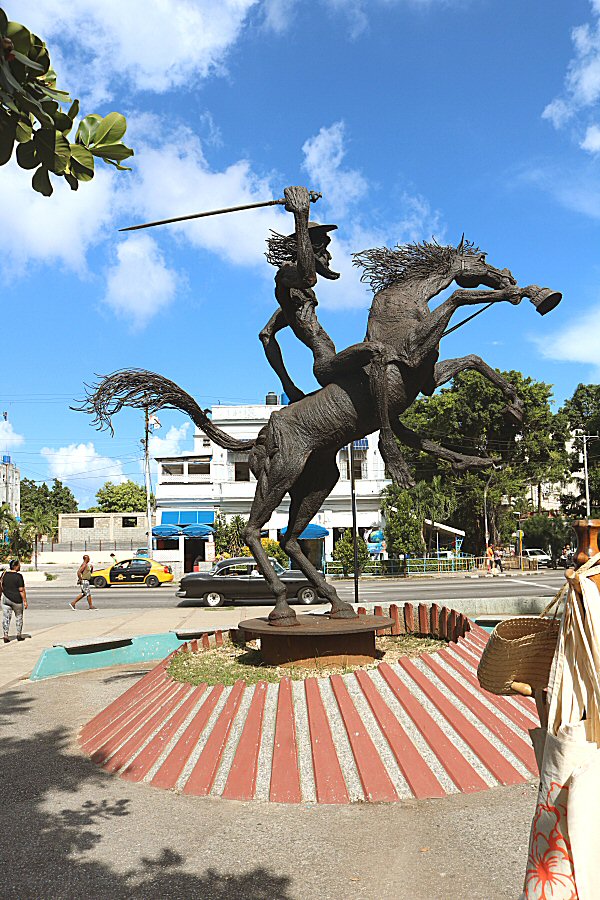 In the Parque del Quijote de las
Américas in Vedado, located at the intersection of the
streets 23 and J, there is the statue of Don Quixote of
America that is made of 2 tons of welded iron wires. It is
the work of the Cuban artist Sergio Martinez. The statue
stands in the park since 1980. Don Quijote is represented
naked on his rampant horse Rocinante. He wears a long sword
in his right hand, referring to the struggle of the Cubans
for freedom and independence during the colonial time. At
the base of the statue the sculptor wrote the following
phrase of the writer: Porque somos de España en Lorca, en
Machado, en Miguel, porque España es la última mirada del
sol del Pablo nuestro, porque nunca hemos medido el tamaño
de los molinos de viento y sentimos bajo nuestros talones el
costillar de rocinante. (Because we are from Spain in Lorca,
in Machado, in Miguel, because Spain is the last look of the
sun of our Pablo, because we have never measured the size of
the windmills and feel the ribs of Rocinante under our
heels).
In the Parque del Quijote de las
Américas in Vedado, located at the intersection of the
streets 23 and J, there is the statue of Don Quixote of
America that is made of 2 tons of welded iron wires. It is
the work of the Cuban artist Sergio Martinez. The statue
stands in the park since 1980. Don Quijote is represented
naked on his rampant horse Rocinante. He wears a long sword
in his right hand, referring to the struggle of the Cubans
for freedom and independence during the colonial time. At
the base of the statue the sculptor wrote the following
phrase of the writer: Porque somos de España en Lorca, en
Machado, en Miguel, porque España es la última mirada del
sol del Pablo nuestro, porque nunca hemos medido el tamaño
de los molinos de viento y sentimos bajo nuestros talones el
costillar de rocinante. (Because we are from Spain in Lorca,
in Machado, in Miguel, because Spain is the last look of the
sun of our Pablo, because we have never measured the size of
the windmills and feel the ribs of Rocinante under our
heels).
Sergio Martinez made another statue of Don
Quijote, composed of copper wires, in 1981. The three meters
high statue is in the Central Palace of Pioneers Ernesto Che
Guevara, in the garden of a primary school, in the vicinity
of the Parque Lenin, on the outskirts of Havana.
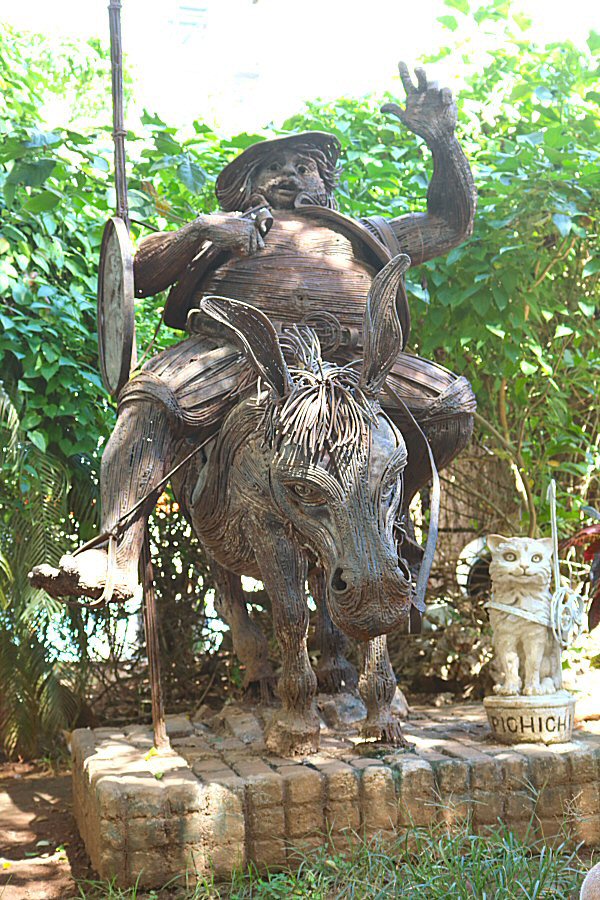
In the small park at the intersection of the Obispo and the Aguacate streets, there is the statue of Don Quijote’s faithful squire Sancho Panza (El Sancho de la Habana), made of iron wires. It is the work of the Cuban sculptor Leo Lázaro and was made in 1989. The statue traveled through various places until it reached its current localization. Sancho Panza is represented greeting people with his left hand on his Rucio and holds a spear and an adarga (hard leather shield used originally by the Moors of Spain) in his right hand. The Knight of the Sad Figure (Don Quijote) is carved on his adarga.
